
Acanthosphinx is a monotypic moth genus in the family Sphingidae erected by Per Olof Christopher Aurivillius in 1891. Its only species, Acanthosphinx guessfeldti, the widow sphinx, was first described by Hermann Dewitz in 1879. It is known from forests from Sierra Leone to the Congo, Angola, Zambia, Malawi, Tanzania and Uganda.

Chloroclanis is a genus of moths in the family Sphingidae, containing one species, Chloroclanis virescens, which is known from forest from west Africa to Angola, the Congo, Uganda and western Kenya and Tanzania.
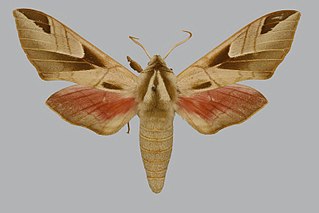
Leptoclanis is a genus of moths in the family Sphingidae, containing one species Leptoclanis pulchra, it is known from Brachystegia woodland from Angola and Zimbabwe to Zambia, the Democratic Republic of the Congo and southern Tanzania.

Polyptychopsis is a genus of moths in the family Sphingidae. It contains only one species, Polyptychopsis marshalli, which is known from Brachystegia woodland in large parts of Africa.

Neopolyptychus convexus is a moth of the family Sphingidae. It is known from Brachystegia woodland in the Democratic Republic of the Congo, Zambia and western Tanzania.
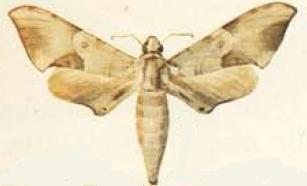
Neopolyptychus compar is a moth of the family Sphingidae. It is known from Brachystegia woodland from Zimbabwe to Mozambique, Zambia, Malawi and south-eastern Tanzania.

Rufoclanis rosea is a moth of the family Sphingidae first described by Herbert Druce in 1882. It is known from forests in Burkina Faso, Ghana, Cameroon, Gabon, the Central African Republic, Tanzania and Uganda.

Rufoclanis numosae, the wavy polyptychus, is a moth of the family Sphingidae. The species was first described by Hans Daniel Johan Wallengren in 1860. It is known from dry bush and arid savanna in much of eastern and southern Africa.
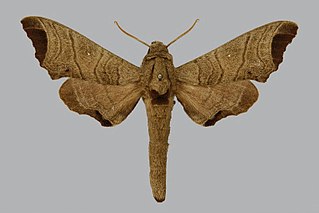
Likoma apicalis is a moth of the family Sphingidae. It is known from savanna and open woodland in the Democratic Republic of the Congo, Zambia, Malawi, Tanzania and Kenya.
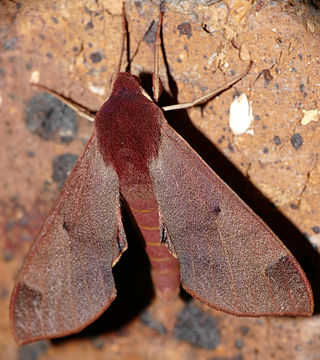
Afroclanis calcareus is a moth of the family Sphingidae. It is known from Brachystegia woodland from northern South Africa, Zimbabwe and Mozambique to Malawi, Zambia, the Democratic Republic of the Congo and Tanzania.

Phylloxiphia punctum is a moth of the family Sphingidae. It is known from savanna from north-eastern South Africa to Zimbabwe, Zambia, the Democratic Republic of the Congo and Tanzania.

Phylloxiphia metria is a moth of the family Sphingidae. It is known to be from Brachystegia woodland of Mozambique to Zambia and the Democratic Republic of the Congo, and north to Malawi and Tanzania.
Phylloxiphia formosa is a moth of the family Sphingidae. It is found from Sierra Leone, Liberia and Ivory Coast to the Central African Republic, Uganda and Tanzania, south to Zambia.

Leucophlebia xanthopis is a moth of the family Sphingidae. It is known from the Democratic Republic of the Congo and Tanzania.

Antinephele lunulata is a moth of the family Sphingidae. It was described by Rothschild and Jordan in 1903, and is known from forests and wooded habitats from Sierra Leone to Cameroon, the Democratic Republic of the Congo, Zambia, Zimbabwe and Tanzania, as well as Madagascar.

Antinephele maculifera is a moth of the family Sphingidae. It was described by William Jacob Holland in 1889, and is known from Sierra Leone to the Democratic Republic of the Congo and Uganda. It is also found in Kenya, Malawi, Tanzania and Zimbabwe. It is known from forests and wooded habitats.
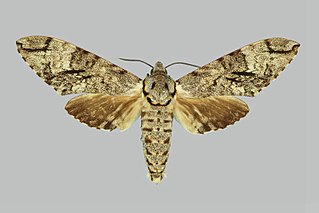
Macropoliana ferax is a moth of the family Sphingidae. It is known from highland forests in East Africa, including the Democratic Republic of the Congo, Rwanda, Tanzania, Kenya and Malawi.

Temnora funebris is a moth of the family Sphingidae first described by William Jacob Holland in 1893. It is known from the forests of western Africa to the Democratic Republic of the Congo, Uganda, Tanzania and Zimbabwe.

Temnora crenulata is a moth of the family Sphingidae. It is known from forests from Sierra Leone to Congo, Uganda and western Kenya, with an isolated population in the Usambara Mountains of north-eastern Tanzania.

Nephele bipartita is a moth of the family Sphingidae. It is known from lowland forest and heavy woodland from West Africa to the coast of Kenya and Tanzania and to Malawi and Mozambique.

















